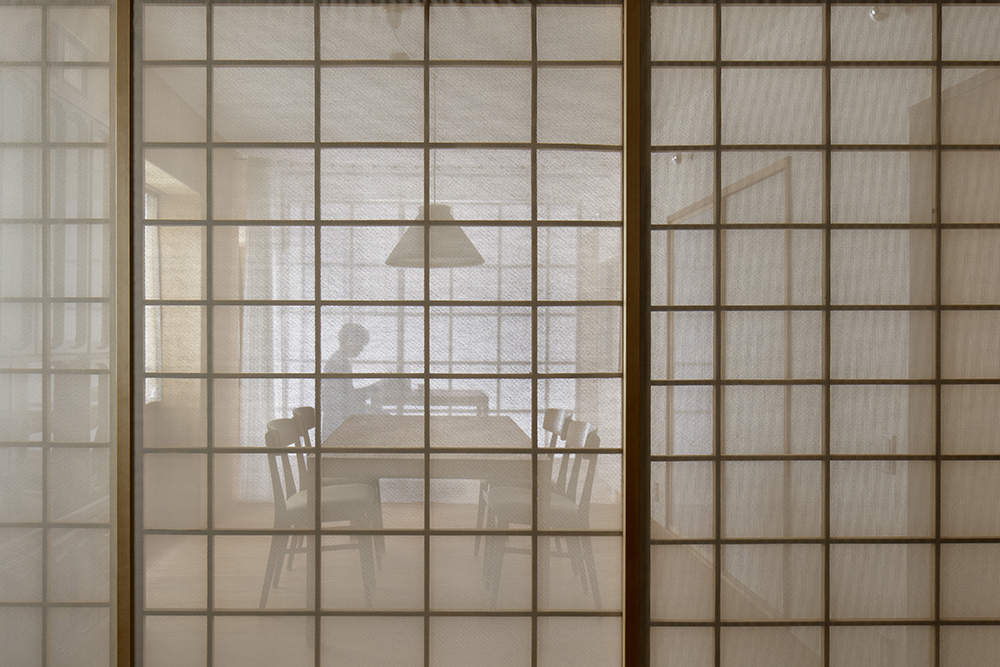/東成瀬の4層 2018








2人の子どもの自立後、余生を生きるための初老の夫婦の住まいである。
90年代初頭に建てられたスキップフロア型のマンションであるため、南北にバルコニーをもつ。南北に長い室内はもともと4室に分割されており、北側の室は冬は寒くカビが生えやすく、南側の室は夏は暑いというように、室ごとの環境差が顕著であった。一方で、4室をつなぐ廊下の空間は南北につなぐように建具を開けば心地よい風が流れ、壁を解体してワンルームにすれば環境差をなくすことが容易なのは明らかであった。
施主からはその環境差の改善を求められた。また頻繁に来る孫が安心して眠る場所、一人になる趣味の部屋、ご近所さんの応接の場所、ときどき仕事できる場所、たまに大人数で集まれる場所、年に数回のゲストの宿泊部屋、などとさまざまな過ごし方の要望がその頻度とともに提示された。
要望の多くは、2人だけの終の住処を豊かにするだけでなく、子どもがいなくなり生まれた余剰のスペースを活用して、住宅が本来持っていたはずの、さまざまな時間軸をもつ他者との関わり方や人の集まり方を許容する空間を求めているように思えた。そこでその要望を、時間軸を介在させた室と室の関係性ひいては境界のあり方の問題ととらえなおし、もともとあった4室の境界面(A:メクラの三枚襖、B:押入と間仕切壁、C:間仕切壁)を、それぞれ既存を生かしつつも手を加えることで、異なる性能を持つ境界面に生まれ変わらせた。
機能主義によった4室でも、不均質なワンルームでもなく、境界の再定義により住宅内に複数の層を生み出すこと。南北に細長い4室の環境差を完全にとりはらうのではなく、その既存の骨格を尊重しながら、それらの環境差を状況に応じて自由に伸び縮みさせられる住まいにした。複数の層は住まい手の過ごし方に冗長性を担保し、2人の終の住処において、子どもや孫、来客などの他者がそれぞれの距離感で共存することを容易にする。層をもつ住宅が、初老の夫婦が二人だけの世界に閉じることのない生き方に答えられるのではないかという仮説の検証である。
所在地:神奈川県伊勢原市
主要用途:専用住宅
延床面積:98.11㎡
撮影:繁田 諭
The residence belongs to an elderly couple, now alone after the independence of the two children.
The building is a Split-level apartment built in the early 1990s, with a balcony in the north and south side. The long interior, oriented north-south, was originally divided into four rooms. The rooms in the north side were cold in winter and molds were easy to grow, while the rooms in the south were hot in the summer. The environmental difference in each room was remarkable. On the other hand, it was obvious that, disassembling the walls into one room, a comfortable wind would flow, eliminating the climate difference. The client required a number of transformations: improve the environmental conditions; create safe places where the grandchildren could come and sleep; a hobby room to be alone; a place to receive the neighborhoods; a place where you can work occasionally; a place where you can get together at a large number of occasions; a guest room to be used a few times a year, etc Requests of various spaces and uses were presented with their frequency. Many of the requests are not only to enrich the space of the last two residents, but also to utilize the surplus space left as a son leaves the house, and to make it easier for others who have different time axes. The goal was to create a place to help people associate and gather.The owner’s demands were interpreted as relationships between the rooms and the time axis, and as a matter of how the boundary is presented.
The interfaces of the four rooms originally (A: three sliding doors, B: entrance and partition wall, C: Partition wall) were reborn as boundary surfaces with different characters, by subtly retouching while taking advantage of existing. With this intervention, the redefinition of the boundaries created multiple layers in the house. The space is thus defined by being both four functional rooms and a single heterogeneous room. While respecting the existing skeleton of the four long and narrow rooms, the residences are able to freely expand and contract the environment according to the situation. Multiple layers assure redundancy in how to live a house, and facilitate the coexistence of others, such as children, grandchildren, visitors, etc., distancing from the idea of the last residence place of the two people. This project represents the idea that houses with different layers can be an answer to avoid elderly couple living in a world where there are only two people.
Location: Isehara City, Kanagawa Prefecture
Main use: Private housing
Total floor area: 98.11 m²
Shooting: Satoshi Shigeta
